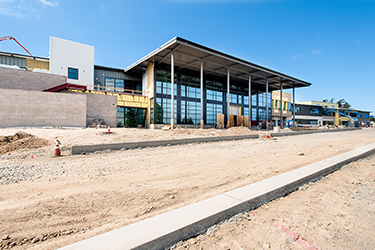|
Subscribe / Renew |
|
|
Contact Us |
|
| ► Subscribe to our Free Weekly Newsletter | |
| home | Welcome, sign in or click here to subscribe. | login |
Construction
| |
 |
August 30, 2018
Stretch your tight budget by getting creative
Forma Construction

Rich
|
In our unprecedented regional construction boom, local market conditions stress every construction budget — and public schools are no exception.
General contractors have little control over the exaggerated market forces we’re currently seeing, but experienced school builders can assist districts with mitigating them. If confronted head on, today’s budget challenges can be eased, minimizing their compounding effects through careful scheduling and strategic teaming decisions.
Strained budgets
Most of the funding for public school construction comes from bond measures, which require meticulous planning and political negotiations to get approved. In bond planning, stakeholders begin by assessing the district’s needs, eventually arriving at a value that translates into a tax rate.
Politics drive the next steps, which often include reducing both identified needs and targeted costs in order to arrive at something that will be approved by local voters. Finding this balance generally results in budget reductions and tax rate compromises.
Once passed, districts are bound to deliver what was promised to voters or face the consequence of being unable to renew bond funding for future projects.
Our current construction market is flooded with work, and the rising price of commodities results in a narrower range of bid results, often skewing towards the upper end of — or beyond — district estimates. Unfortunately, the bonds and tax rates approved by voters often fall short of supporting the district’s real needs — all before considering price escalation.
Thankfully there are still creative solutions districts can apply to make the most of their strained school construction budgets.
Timing is everything
You can always count on school starting back up in September. Our educational calendar is usually the deciding factor in the planning, bidding and construction of schools. For K-8 schools, the site’s size and existing facilities generally lead to a 13- to 16-month construction schedule — or two summers and a school year.
Regionally, there are a limited number of general contractors and specialized subcontractors who dedicate their resources to schools’ cyclical work flow. But with similar construction booms in local housing, technology, biotech and health care sectors, the region’s contractors are struggling to keep up with the demand on labor and construction materials.
School districts are competing directly for these limited resources. Being first to market during the early spring bid cycle can ensure better pricing than summer. Pushing schedules out later and taking projects to bid at the end of the spring can result in inflated pricing, reflecting the contractors’ risk in pursuing additional work when resources are limited and securing materials is more challenging.
This is where an opportunity exists to challenge the status quo by allowing a school to open “off cycle” — for example, not in September, but perhaps at the start of second semester, in January. Another schedule shift could simply involve requiring the building be permitted and ready to bid in December as opposed to May.
This strategy allows districts to contract with builders early and helps GCs get a head start on securing subs.
Alternative delivery
More often, districts are using alternative delivery methods like GC/CM and design-build, securing contractors and resources ahead of typical bidding seasons, ensuring their projects will garner competitive bids from experienced teams.
Another way of securing subs is by hiring mechanical and electrical subcontractors early through MC/CM and EC/CM contracts. This gives the GC/CM or design-build team access to MEP subcontractors’ expertise, which can be integrated more efficiently into the project as it moves from pre-construction to construction.
Furthermore, the apparent benefits of alternative delivery methods have led to districts bundling multiple school projects into larger contracts. This serves the dual purpose of enabling the district to secure construction staff and build resources while benefiting from the logistical and financial efficiencies that one design-builder or GC/CM can achieve across multiple projects.
Reconsidering the size
Despite the best pre-construction planning, a project may reach a point where no amount of system optimization or value engineering can realign it with its budget.
At times like these, district stakeholders must begin by revisiting the physical size of the school project. This process can be painful for community stakeholders and district leadership as well as the design and construction team, who have all been working collectively toward an ideal end goal.
Sometimes these projects fit the true needs of the district but are out of alignment with what was able to get approved through bond measures.
The simple fact is that a project’s square footage is the single greatest driver of construction costs. Despite furniture and fixtures and the levels of finish quality, budgets are simple arithmetic: units multiplied by unit price. In this equation, focusing on how those unit counts were identified at the start of the project can help inform where the math went wrong.
Keeping perspective
Throughout the project planning phase, users are often replacing a school building that is long past its useful life. The limitations of an existing facility will probably be identified as a top priority in its replacement, but this could result in costly design decisions.
Whether it’s a focus on toilet counts, acoustical performance, thermal comfort or classroom size, it is important that we help end users identify their needs in a realistic context, ensuring that the resulting design doesn’t overcompensate — compounding budget problems.
This region is experiencing unprecedented growth in job opportunities, population and a rise in home prices — all of which directly impact the needs of our community schools. With budgets stretched thin, our local school districts are working tirelessly to deliver state-of-the-art learning facilities for students of all ages.
With the right design and construction partners at their side and some creative planning, school districts can make the most of every project dollar.
Brian Rich is chief estimator at Forma Construction. With nearly two decades of experience in estimating, project forecasting and pre-construction, Rich leads estimating for all of Forma’s education projects.
Other Stories:
- It's much easier for schools to get to net zero
- How enviro consultants can lend your school project a helping hand
- UW Life Sciences Building: giant firs and bird songs offer a one-of-a-kind elevator ride
- 3 keys to building green schools: design, operations and renewables
- Bremerton alternative school breaks down walls to learning
- Studies suggest design really can affect how well students learn
- The view from inside a school: what really makes it safe
- Eastside Prep’s versatile arts hall made for concerts, plays and yoga
- After two decades, UW’s SLU campus nears completion
- How playgrounds make all children feel welcome
- See-through schools spark interest in learning
- Schools have more ways than ever to go green
- OSU football center opts for flexible lighting scheme
- Long-distance teams worked in concert to remake Wyoming school theater



